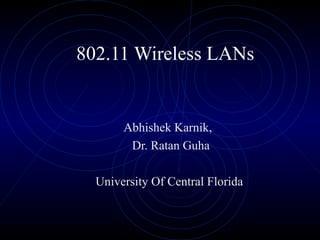This document discusses the 802.11 wireless LAN standards. It provides an overview of 802.11 basics such as the basic service set, distributed coordinated function using CSMA/CA, and point coordinated function. It then discusses the 802.11e amendment which introduced mechanisms for quality of service such as enhanced distributed channel access with prioritized access categories and hybrid coordinated function controlled channel access. The purpose of 802.11e is to provide quality of service capabilities for applications with time-critical traffic over wireless LANs.


























![QoS Support Mechanisms of 802.11e :
EDCA :
• Introduction of 4 Access Categories ( AC ) with 8 Traffic
Classes ( TC )
• MSDU are delivered through multiple back offs
within one station using AC specific parameters.
• Each AC independently starts a back off after
detecting the channel being idle for AIFS
• After waiting AIFS , each back off sets counter from
number drawn from interval [1,CW+1]
• newCW [AC] >= ((oldCW[TC] + 1 ) * PF ) - 1](https://image.slidesharecdn.com/80211-120822044232-phpapp01/85/80211-27-320.jpg)
![AC_VO [0] AC_VI [1] AC_BE [2] AC_BK [3]
AIFSN 2 2 3 7
CWmin 3 7 15 15
CWmax 7 15 1023 1023
Prioritized Channel Access is realized with the QoS
parameters per TC, which include :
• AIFS[AC]
• CWmin[AC]
• PF[AC]](https://image.slidesharecdn.com/80211-120822044232-phpapp01/85/80211-28-320.jpg)

![Access Category based Back-offs
AIFS[AC3]
AIFS[AC2]
AIFS[AC1]
AIFS[AC0]
BackOff[AC3] + Frame
BackOff[AC2] + Frame
BackOff[AC1] + Frame
ACK BackOff[AC0] + Frame](https://image.slidesharecdn.com/80211-120822044232-phpapp01/85/80211-30-320.jpg)
![QoS Parameter Set Element Format
CWmin[AC] CWmax[AC]
Element ID
CWmin[0]….CWmin[3] CWmax[0]….CWmax[3]
AIFSN[AC] TxOPLimit[AC]
AIFSN[0]….AIFSN[3] TxOP[0]….TxOP[3]
AIFS [AC] = AIFSN [AC] * aSlotTime + SIFS](https://image.slidesharecdn.com/80211-120822044232-phpapp01/85/80211-31-320.jpg)




![Example :
AC[0] AC[1] AC[2]
AIFSN 2 4 7
CWmin 7 10 15
CWmax 7 31 255
PF 1 2 2](https://image.slidesharecdn.com/80211-120822044232-phpapp01/85/80211-36-320.jpg)
![AIFS[AC] = AIFSN[AC] * aSlotTime + SIFS
PIFS - 25 µsec ( Used in HCCA)
SIFS - 16 µsec
Slot Time - 9 µsec
AIFS[0] = (2 * 9) + 16 = 34 µsec = DIFS
AIFS[1] = (4 * 9) + 16 = 52 µsec (52 – 34) / 9 = 18/9 = 2 Slots
AIFS[2] = (7 * 9) + 16 = 79 µsec (79 – 34) / 9 = 45/9 = 5 Slots](https://image.slidesharecdn.com/80211-120822044232-phpapp01/85/80211-37-320.jpg)
![Back-off Algorithm :
802.11 : CWRANGE = [ 0 , 2 2+i – 1 ]
802.11e : newCW[AC] = [(oldCW[AC] + 1) * PF] - 1
Collision1 Collision2 Collision3
AC[0] [(7+1)*1]-1 = 7 ( 0-7 ) ( 0-7 )
(0-7)
AC[1] [(10+1)*2]-1 = 21 [(21+1)*2]-1 = 43 ( 0 – 31 )
( 0 - 21 ) ( 0 – 31 )
AC[2] [(15+1)*2]-1 = 31 [(31+1)*2]-1 = 63 [(63+1)*2]-1 =
( 0 – 31 ) ( 0 – 63 ) 127
( 0 – 127 )](https://image.slidesharecdn.com/80211-120822044232-phpapp01/85/80211-38-320.jpg)











